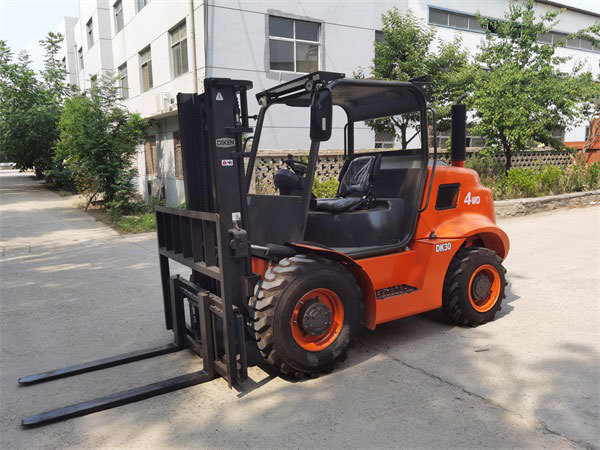Diken news
Boost Efficiency: The Role of Off Road Forklifts in Heavy-Duty Tasks
Release time: 2025-03-30
Boost Efficiency: The Role of Off Road Forklifts in Heavy-Duty Tasks
Table of Contents
- 1. Introduction to Off Road Forklifts
- 2. What are Off Road Forklifts?
- 3. Key Features and Design Elements of Off Road Forklifts
- 4. Applications of Off Road Forklifts in Various Industries
- 5. Benefits of Using Off Road Forklifts for Heavy-Duty Tasks
- 6. Enhancing Efficiency with Off Road Forklifts
- 7. Safety Considerations When Operating Off Road Forklifts
- 8. Maintenance Tips for Off Road Forklifts
- 9. Conclusion
- 10. FAQs
1. Introduction to Off Road Forklifts
In the fast-paced world of heavy-duty tasks, efficiency is paramount. Businesses in various sectors, from construction to agriculture, constantly seek ways to optimize their operations. One significant innovation contributing to this goal is the off-road forklift. These specialized machines are designed to tackle the rigors of outdoor environments, providing unparalleled versatility and productivity.
In this article, we will explore how off-road forklifts enhance efficiency across diverse industries, their unique features, applications, and their role in boosting overall productivity and safety.
2. What are Off Road Forklifts?
Off-road forklifts are heavy-duty material handling machines specifically engineered for challenging terrains. Unlike standard forklifts, which are primarily designed for smooth, paved surfaces, off-road forklifts are equipped with features that enable them to navigate rough, uneven landscapes.
These vehicles come with larger tires, enhanced ground clearance, and robust suspension systems, making them ideal for various applications in sectors such as construction, agriculture, forestry, and mining. Their design allows them to lift and transport heavy loads over rugged surfaces, significantly improving operational efficiency.
3. Key Features and Design Elements of Off Road Forklifts
Understanding the design of off-road forklifts is crucial to appreciating their efficiency-enhancing capabilities. Here are some of their standout features:
3.1 Enhanced Tire Design
Off-road forklifts typically feature larger, wider tires with deep treads to provide superior traction on uneven surfaces. This design minimizes slippage, ensuring that the forklift maintains stability even when navigating steep or muddy terrains.
3.2 Elevated Ground Clearance
These forklifts come with higher ground clearance to prevent damage from obstacles such as rocks, debris, and uneven ground. This feature is critical for maintaining smooth operations in rugged environments.
3.3 Robust Suspension Systems
A robust suspension system helps absorb shocks from rough terrain, allowing for smoother handling and reduced wear on the equipment. This durability contributes to less downtime and lower maintenance costs.
3.4 Powerful Lifting Capabilities
Off-road forklifts are equipped with powerful lifting mechanisms that enable them to handle substantial loads. This capability is essential for industries that require the movement of heavy materials, ensuring that tasks are completed more efficiently.
4. Applications of Off Road Forklifts in Various Industries
Off-road forklifts play a critical role in numerous industries, each with unique demands that these machines can address effectively. Below are some primary applications:
4.1 Construction
In construction sites, off-road forklifts facilitate the transportation of heavy materials such as concrete blocks, steel beams, and equipment. Their ability to navigate uneven surfaces allows for efficient operations even in adverse weather conditions.
4.2 Agriculture
In farming, off-road forklifts are invaluable for transporting heavy loads like bales of hay, feed, and farm machinery across fields. Their design minimizes soil compaction, which is crucial for maintaining soil health.
4.4 Forestry
Forestry operations often require moving logs and other heavy materials through challenging terrains. Off-road forklifts make this task easier, allowing for swift and efficient handling of resources while reducing potential damage to the environment.
4.5 Mining
In the mining industry, off-road forklifts are essential for transporting equipment and materials across rugged mine sites. Their ability to operate in harsh conditions significantly enhances productivity and safety.
5. Benefits of Using Off Road Forklifts for Heavy-Duty Tasks
The adoption of off-road forklifts brings several benefits to businesses engaged in heavy-duty tasks:
5.1 Improved Efficiency
By enabling quicker material handling in challenging environments, off-road forklifts streamline operations, allowing businesses to complete tasks in less time.
5.2 Enhanced Safety
The design of off-road forklifts emphasizes stability and traction. Their capabilities reduce the likelihood of accidents associated with load handling in rough terrains, contributing to a safer work environment.
5.3 Versatility
Off-road forklifts can be equipped with various attachments, allowing them to handle multiple tasks beyond standard lifting. This versatility makes them valuable assets in various operational scenarios.
5.4 Reduced Downtime
Their robust construction and design lead to fewer breakdowns and maintenance issues, ensuring that operations remain uninterrupted.
5.5 Cost-Effectiveness
Investing in off-road forklifts can lead to long-term savings by reducing labor costs, minimizing downtime, and improving overall operational efficiency.
6. Enhancing Efficiency with Off Road Forklifts
To maximize the efficiency of off-road forklifts, businesses should consider the following strategies:
6.1 Operator Training
Proper training for operators ensures that off-road forklifts are used safely and effectively. Skilled operators can navigate challenging terrains and handle loads efficiently.
6.2 Regular Maintenance
Implementing a routine maintenance schedule ensures that off-road forklifts remain in optimal condition, reducing the likelihood of unexpected breakdowns.
6.3 Integration with Technology
Utilizing technology such as GPS tracking and telematics can help optimize routes and monitor performance, leading to more efficient operations.
6.4 Load Management
Understanding load limits and managing loads effectively can prevent overburdening the forklift and reduce wear and tear, leading to increased efficiency.
7. Safety Considerations When Operating Off Road Forklifts
While off-road forklifts offer numerous benefits, safety should remain a priority. Here are essential safety considerations:
7.1 Conducting Pre-Operation Inspections
Before use, operators should conduct thorough inspections of the forklift to identify potential issues such as tire wear or hydraulic leaks.
7.2 Adhering to Load Limits
Operators must understand and adhere to the forklift’s load capacity to prevent tipping and accidents.
7.3 Wearing Proper Safety Gear
Employing safety gear, including helmets, gloves, and protective footwear, ensures that operators are protected in case of accidents.
7.4 Keeping the Work Area Clear
Maintaining a clear and organized work environment reduces the risk of collisions and accidents during operation.
8. Maintenance Tips for Off Road Forklifts
Proper maintenance is crucial for the longevity and efficiency of off-road forklifts. Consider the following tips:
8.1 Regular Fluid Checks
Monitoring fluid levels, including hydraulic fluid and engine oil, is essential for ensuring smooth operation.
8.2 Tire Maintenance
Regularly inspecting and maintaining tire pressure and tread depth is critical for optimal traction and safety.
8.3 Routine Cleaning
Cleaning the forklift regularly helps prevent the buildup of dirt and debris that can affect performance.
8.4 Scheduled Professional Servicing
Engaging professionals for routine servicing can help identify potential issues before they escalate, ensuring that the forklift remains in excellent working condition.
9. Conclusion
Off-road forklifts represent a vital component of heavy-duty operations across various industries. Their unique design, robust features, and versatility make them indispensable for navigating challenging terrains and handling heavy loads. By improving efficiency, enhancing safety, and reducing downtime, these forklifts play a crucial role in optimizing productivity.
As industries continue to evolve, understanding the significance of off-road forklifts will enable businesses to harness their full potential, ultimately leading to greater operational success.
10. FAQs
10.1 What distinguishes off-road forklifts from standard forklifts?
Off-road forklifts are specifically designed for rugged terrains, featuring larger tires, elevated ground clearance, and robust suspension systems, unlike standard forklifts that operate on smooth surfaces.
10.2 What industries benefit from off-road forklifts?
Industries such as construction, agriculture, forestry, and mining commonly utilize off-road forklifts for their ability to handle heavy loads in challenging environments.
10.3 Are off-road forklifts safe to operate?
Yes, when operated following safety guidelines and proper training, off-road forklifts are safe. Implementing safety measures minimizes risks associated with their use.
10.4 How can I maximize the efficiency of off-road forklifts?
Maximizing efficiency involves regular maintenance, proper operator training, load management, and integrating technology for optimized performance.
10.5 What maintenance practices should I follow for off-road forklifts?
Routine inspections of fluid levels, tire conditions, and regular cleaning, along with scheduled professional servicing, are essential for maintaining off-road forklifts in optimal condition.
Keywords: off road forklift










